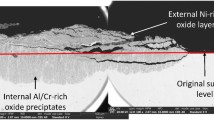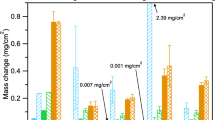Abstract
Hot corrosion of Ni-based superalloys has been extensively studied due to its negative impact on aero-turbine engines. However, the complexity of hot corrosion makes it difficult to discern the degradation pathways of field-exposed parts. To that end, it is technically important to conduct more complex laboratory-scale testing to develop a better understanding of the degradation pathways that may affect a field-exposed part. Na2SO4 has been the principal deposit considered in past studies, but with little consideration given to another common environmental species, NaCl. This study aimed to better understand the role of NaCl in Na2SO4 deposits at 900°C on a 2nd-generation, Ni-based superalloy, PWA 1429. A NaCl-only deposit was also studied to isolate NaCl’s role in affecting degradation. It was found that additions of NaCl induced greater degradation when compared to a Na2SO4-only deposit. Short-term exposures were able to determine that NaCl forms volatile chlorides with nickel that subsequently oxidize to form a porous, non-protective product. In tandem, oxygen ingress causes subsurface aluminum oxidation, which inhibits the formation of a protective oxide on the alloy. The results indicate that NaCl plays a major role early in the degradation process which may be missed during post-analyses after long-term exposures.












Similar content being viewed by others
References
G.H. Meier, Oxid. Met. 98, 1 (2021).
N. Birks, G. Meier, and F. S. Pettit, Introduction to the High Temperature Oxidation of Metals, 2nd ed. (Cambridge University Press, 2006).
J.G. Tschinkel, Corrosion 28, 161 (1972).
D. A. Shifler, J. Eng. Gas Turbine Power 1 (2017).
J. F. G. Conde, in Gas Turbine Materials Conference Proceedings (1972), pp. 17–26.
J. F. G. Conde, in AGARD Conference Proceedings (1972), pp. 204–219.
J. F. G. Conde and B. A. Wareham, in Proceedings of the 1974 Gas Turbine Materials in the Marine Environment Conference (1974), pp. 73–92.
D.W. McKee, D.A. Shores, and K.L. Luthra, J. Electrochem. Soc. 125, 411 (1978).
H.J. Grabke, M. Spiegel, and A. Zahs, Mater. Res. 7, 89 (2004).
M. Li, X. Sun, W. Hu, H. Guan, and S. Chen, Oxid. Met. 65, 137 (2006).
R.C. Reed, The Superalloys: Fundamentals and Applications (Cambridge University Press, Cambridge, 2006).
R. Darolia, Int. Mater. Rev. 64, 355 (2019).
A. D. Cetel and D. N. Duhl, Superalloys 235 (1988).
I. Gurrappa, Oxid. Met. 51, 353 (1999).
M. Mobin, A.U. Malik, and S. Ahmad, J. Less-Common Metals 160, 1 (1990).
A. Roine, HSC Chemistry 10 [Software] (2023).
I.N. Ozeryanaya, Met. Sci. Heat Treat. 27, 184 (1985).
R. Bianco, J. Electrochem. Soc. 136, 265C (1989).
Ihsan Barin, Thermochemical Data of Pure Substances, 3rd ed. (1995).
B. Grégoire, C. Oskay, T.M. Meißner, and M.C. Galetz, Sol. Energy Mater. Sol. Cells 215, 1 (2020).
B.P. Mohanty and D.A. Shores, Corros. Sci. 46, 2893 (2004).
S.C. Kung and R.A. Rapp, J. Electrochem. Soc. 135, 731 (1988).
A. Nishikata, H. Numata, and T. Tsuru, Mater. Sci. Eng. A 146, 15 (1991).
J.C. Gomez-Vidal and R. Tirawat, Sol. Energy Mater. Sol. Cells 157, 234 (2016).
J. Tjandra, A. Ranjan, A.K. Ackerman, M. Appleton, and S. Pedrazzini, Metall. Mater. Trans. A Phys. Metall. Mater. Sci. 54A, 3286 (2023).
C.C. Tsaur, J.C. Rock, C.J. Wang, and Y.H. Su, Mater. Chem. Phys. 89, 445 (2005).
G.C. Fryburg, F.J. Kohl, C.A. Stearns, and W.L. Fielder, J. Electrochem. Soc. 129, 571 (1982).
D.A. Shores, and B.P. Mohanty, Corros. Sci. 46, 2909 (2004).
A. K. Misra and D. P. Whittle, EFFECT OF CHLORIDES ON Na2SO4-INDUCED HOT CORROSION OF MCrAl’s, Lawrence Berkeley National Laboratory, LBNL Report #: LBL-14388 (1982).
W. Da Costa, B. Gleeson, and D.J. Young, J. Electrochem. Soc. 141, 1464 (1994).
G. W. Goward and L. L. Seigle, in ASM Handbook (1994), pp. 611–617.
J.X. Chang, D. Wang, T. Liu, G. Zhang, L.H. Lou, and J. Zhang, Corros. Sci. 98, 585 (2015).
V.I. Hanby, J. Eng. Power 96, 129 (1974).
Acknowledgements
This research was supported by the Office of Naval Research through contract number N000142112596 managed by Dr. David Shifler. Student support was provided by the Center for Energy through the R.K. Mellon Foundation.
Author information
Authors and Affiliations
Corresponding author
Ethics declarations
Conflict of interest
On behalf of all authors, the corresponding author states that there is no conflict of interest.
Additional information
Publisher's Note
Springer Nature remains neutral with regard to jurisdictional claims in published maps and institutional affiliations.
Rights and permissions
Springer Nature or its licensor (e.g. a society or other partner) holds exclusive rights to this article under a publishing agreement with the author(s) or other rightsholder(s); author self-archiving of the accepted manuscript version of this article is solely governed by the terms of such publishing agreement and applicable law.
About this article
Cite this article
Nguyen, P., Konitzer, D. & Gleeson, B. Effect and Role of NaCl in Na2SO4 Deposits on the 900°C Hot Corrosion of a 2nd-Generation Ni-based Superalloy. JOM (2024). https://doi.org/10.1007/s11837-024-06509-2
Received:
Accepted:
Published:
DOI: https://doi.org/10.1007/s11837-024-06509-2




